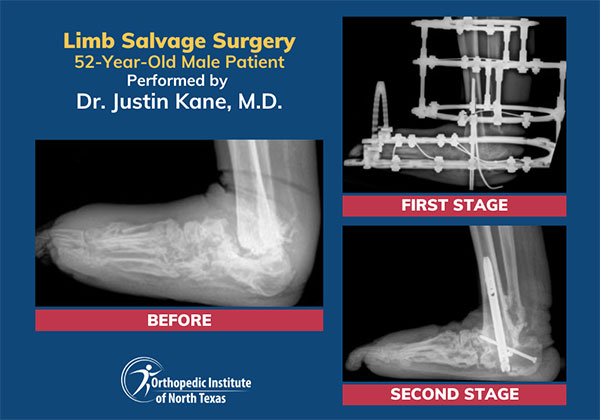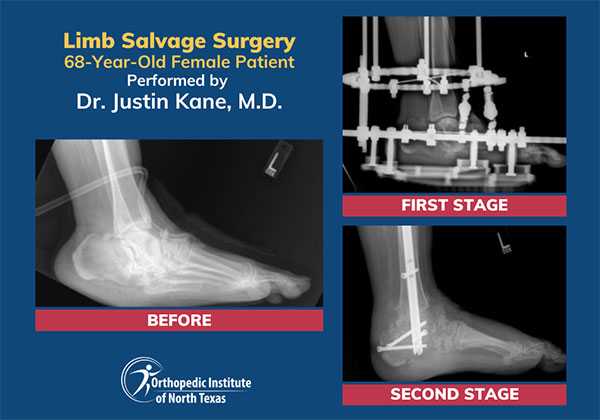Limb Salvage/Charcot
Charcot neuroarthropathy of the foot is an advanced complication of diabetes and other peripheral neuropathies (nerve damage). This destructive joint disorder is caused by ongoing injuries to a neuropathic foot that becomes insensitive to pain (insensate). Charcot neuroarthropathy can lead to deformity, pain, ulcers, and infections, as well as disability. Patients dealing with further complications like bone and joint fragmentation of the foot, osteomyelitis, or even amputation may benefit from limb salvage surgery that preserves as much of the foot as possible.
What Is Limb Salvage Surgery?
Limb salvage, or limb-sparing surgery, comprises the surgical techniques and procedures that help to preserve a Charcot foot. It is an alternative to amputation, especially where conditions like osteomyelitis have led to a significant loss of bone, tissue degradation, and structural instability. Our surgeons can prevent the sacrifice of your foot by using bone and soft tissue reconstruction, tendon transfer, and external fixation to preserve the structure and function of the foot.
When possible, limb salvage is preferable to amputation. Patients have a higher level of functioning when limb salvage is successful when compared to amputation. Also, limb salvage surgery is thought to prolong the life of diabetic patients when compared to amputation.
What Are the Benefits of Limb Salvage Surgery?
Limb salvage surgery becomes necessary when conservative strategies to decrease impacts on your foot have been exhausted. Limb-sparing surgery helps patients with advanced Charcot foot to avoid the complete amputation of the foot. Other benefits of limb salvage surgery include the following:
- Restoration of stable ambulation with the sole of the foot in contact with the ground.
- Improvement of the appearance and function of the foot.
- Prevention of ulceration and progression of deformities.
- Promotion of wound healing.
- Restoration and maintenance of joint stability.
- Preservation of as much of the foot as possible.
- Cost-effectiveness when compared to limb amputation.
- Improvement of quality of life and psychological well-being.
- Possible resumption of patient shoe-wearing
What Does Limb Salvage Surgery Involve?
In this procedure, also known as a Charcot reconstruction, your surgeon cuts, realigns, and fuses the bones of the foot and ankle. It's carried out under general anesthetic, with your surgeon making incisions on the affected foot and ankle to allow access and exploration of affected joints and bones.
Individual bones are shortened or lengthened with bone grafts and manipulated into more favorable positions. Once aligned, they are fixed with plates or screws to maximize stability. Intraoperative fluoroscopy (real-time X-ray imaging) is also used to aid precision and ensure that functionality is preserved.
The timing of surgery is critical because, during the acute Charcot phase, healing can be compromised by excessive inflammation and a cytokine storm (an aggressive immune response) that causes excessive edema and bone degradation. The soft bone of a Charcot limb is an additional challenge for applying hardware for fusions. To prevent any unwanted movement of the foot, your surgeon may secure the foot joints with an external fixator until bone healing and fusion have been radiographically established. All incisions are closed and dressed.
Who Is an Ideal Candidate for Limb Salvage Surgery?
Limb salvage surgery for Charcot foot is often a late-stage procedure that is considered for patients who are experiencing severe deformity, ulceration, and pain. We may consider surgery for you at an earlier stage of the condition if there is an infection, a severe dislocation, joint instability, or potential for skin breakdown. Other indications for Charcot reconstruction include the following:
- Severe redness and joint swelling
- Bones pressing against your footwear
- Bone or joint collapse
- Loss of firmness of the foot
- Development of recurrent pressure sores
- Ulceration
- Osteomyelitis (infection of the bone)
- Loss of stability in the foot
- Altered posture
- Reduced mobility
- Recurrent fractures and dislocations in the bones and joints of the foot
- Abnormal twisting of the ankle
- Foot deformity
- Curled toes
How Limb Salvage Surgery Impacts Lives
Success Story: 52-Year Old Male

A 52-year old male sought a second opinion after receiving news that he needed an amputation for a bone infection, known as osteomyelitis, and Charcot. His condition was complicated due to type 2 diabetes and end-stage renal disease, which required dialysis.
Dr. Kane evaluated and treated this patient with a two-stage procedure (above). The first stage cleaned out the bone infection and realigned his foot with an external fixator. The second stage had our doctor perform the procedure for final realignment.
As a result, this patient can walk again in regular shoes with a diabetic insert, returning to a more normal daily life and routine.
Success Story: 68-Year Old Female

In another case, a 68-year old female with type 2 diabetes sought treatment for Charcot and an enlarged diabetic foot ulcer tha developed due to the deformity. She met with Dr. Kane to review her case and determine her best course of action, which was also a two-stage procedure (above).
The first stage cleaned out the infection and realigned her foot with an external fixator. The second stage. The second stage required Dr. Kane to perform a procedure for the final realignment of the patient’s foot.
As a result of the limb salvage surgery, this patient can now walk in a custom diabetic shoe and regain a more normal routine.
Justin M. Kane, M.D.
Board Certified Foot & Ankle Orthopedic Surgeon
Justin M. Kane, MD, is an orthopedic surgeon educated at Rensselaer Polytechnic and Thomas Jefferson University. He trained at Temple University Hospital and completed his residency at The Rothman Institute at Thomas Jefferson University Hospital. Following a foot and ankle surgery fellowship at Baylor University Medical Center, he practiced at Baylor and directed research at the Human Motion and Performance Center.
Dr. Kane founded the Orthopedic Institute of North Texas, where he treats a range of foot and ankle conditions and performs advanced reconstructive surgeries. He has published extensively and contributes to orthopedic education and research.
Beyond his practice, Dr. Kane is involved in international medical missions, including in Vietnam with AOFAS and MOI, and in the Dominican Republic with Rush University.
Considering Limb Salvage Surgery? Talk to Dr. Kane.
Our team at the Orthopedic Institute of North Texas is highly experienced in limb salvage procedures and can work with your primary care physician and endocrinologist to provide seamless multidisciplinary care as part of a limb salvage procedure. The surgeons at the Orthopedic Institute of North Texas regularly lecture and teach nationally and internationally with the most up-to-date techniques to improve successful outcomes for Charcot surgery. We're committed to providing friendly, respectful, and patient-focused care, from your first appointment through your postoperative recovery. Book an appointment at our offices where we can discuss your options and assist you in developing a treatment plan that will preserve your mobility and improve your quality of life.
Frequently Asked Questions
What Causes a Charcot Foot?
The primary cause of this condition is diabetes-related nerve damage, which leads to a loss of sensation in the lower limb and foot. This causes an accumulation of injuries and infections that can go unrecognized. The associated inflammation is destructive, causing progressive breakdown and collapse of soft tissue and bone.
Does Limb Salvage Surgery Have Complications?
Limb salvage surgery does have risks and can be complicated by diabetes or other health problems affecting patients. Known complications of a Charcot reconstruction include infection, impaired wound healing, hardware failure, and ongoing instability in the foot and ankle. With attentive care from our team and monitoring of your postoperative progress, the risk of these complications can be minimized, but there may be a need for a repeat operation if they cannot be managed.
What's the Preoperative Process for Limb Salvage Surgery?
As part of the preoperative process, your surgeon will discuss the procedure with you and make sure you understand essential details, like the techniques, risks, and length of the surgery. They will also inform you of any preoperative tests or lab work to complete before the surgery. The preoperative process can vary for each patient, but it may require you to refrain from taking certain medications before the procedure. We will also tell you whether you need to refrain from eating or drinking prior to the surgery.
What Does the Postoperative Recovery From Limb Salvage Surgery Involve?
Limb salvage surgery requires several days of strict bed rest in the immediate postoperative period. Your foot is carefully dressed and should be kept clean, dry, and undisturbed. You must keep your operative foot elevated, and you can expect to be reviewed by our team at regular intervals. Your surgeon can determine when to remove any external fixation used as part of the limb salvage. When healing has progressed, we will recommend a removable boot that should be worn for up to 12 weeks postoperatively.
Once your surgeon determines that you can come out of the boot, you may need a custom brace, shoe, or insert. Your surgeon will follow up with you at regular intervals to ensure you are prescribed the appropriate footwear.
As you recover from surgery, your physicians should direct active treatment and an ongoing review of diabetes or other medical conditions that contributed to the Charcot foot.
